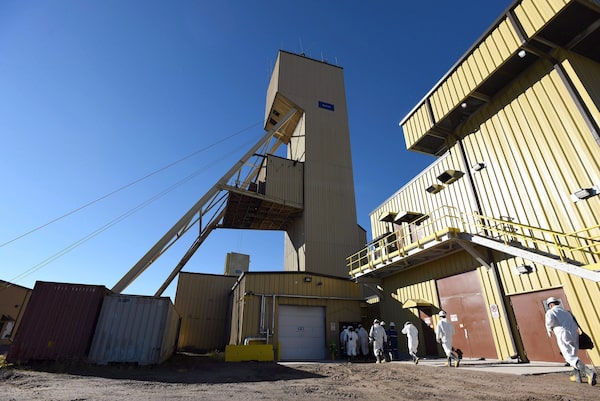
Cameco's uranium mine in Cigar Lake, Sask. on Sept. 23, 2015.Liam Richards/The Canadian Press
For every day of his 10-year tenure at the head of Cameco Corp. , Tim Gitzel has been saddled with a sprawling, costly and potentially ruinous tax dispute with the Canada Revenue Agency over how the uranium producer dealt with its overseas profits.
That dispute was punctuated, if not yet quite ended, on Thursday when the Supreme Court of Canada declined to hear the CRA’s appeal of lower-court decisions that had sided with the company.
The heart of the long-running dispute is transfer pricing, or how multinational companies such as Cameco determine what prices their subsidiaries charge each other for goods and services, with those decisions influencing how much tax is paid in various jurisdictions. Tax lawyers say the Supreme Court decision is a clear repudiation of the CRA’s case, and what they see as an aggressive bid by the agency to rewrite transfer-price agreements that it deemed to be enabling tax avoidance.
The 13-year legal fight cost $60-million, tied up $785-million in cash and lines of credit and took a toll on Cameco’s morale and reputation, said Mr. Gitzel, president and chief executive officer of the Saskatchewan uranium producer. “It’s been very tough on our company, on our employees, especially, and on our balance sheet,” he said in an interview.
The fight isn’t over yet. The case the Supreme Court declined to hear, thereby upholding the June, 2020, decision by the Federal Court of Appeal, dealt with just $11-million in tax debt for only the 2003, 2005 and 2006 tax years. With further legal avenues exhausted, the CRA will have to return $5.5-million to Cameco, plus up to $28.15-million in costs.
But the CRA has also challenged subsequent tax years through to 2014, with a potential tax liability as much as $2.15-billion. And so far, the company does not know how quickly its remaining $779.5-million will be released by the CRA. (That amount reflects the 50 per cent of taxes, interest and penalties owing that large corporations must pay ahead of time to challenge a tax assessment.)
But Mr. Gitzel is celebrating “strong and unequivocal decisions from three levels of court” that have validated Cameco’s contention that its move two decades ago to set up a Swiss subsidiary to sell its uranium in Europe was a legitimate business decision, and not a sham designed to evade taxes, as the CRA alleged.
Under the Cameco structure, it sold uranium to its subsidiary at a fixed price, reflecting market conditions of the early 2000s. In later years, the price of uranium rose substantially, generating profits for the Swiss subsidiary that were then taxed in that country, at a lower rate than would have been the case in Canada.
The CRA then challenged that arrangement, saying that the fixed-price arrangement was not a true arm’s length arrangement and had been set up only to avoid taxes. In doing so, it deployed a rarely used power called the pricing recharacterization rule, a part of the Income Tax Act that allows it to ignore commercial arrangements that a company has struck.
The CRA declined a request for an interview. But in a statement, the agency said it will review the decision in consultation with the finance and justice departments, adding it “considers this an important issue as it relates to international profit shifting and erosion of Canada’s tax base which undermines the government’s ability to provide benefits and services to Canadians.”
Cameco’s victory came in part from a narrow legal distinction in how transfer pricing is assessed. The CRA said the standard should be whether Cameco would have made an identical arrangement with an unrelated company. But Cameco contended that the proper approach would be to assess whether any two parties might come to such an arrangement. The company won that point both in the Tax Court of Canada, and on appeal.
Steve Suarez, a partner at Borden Ladner Gervais LLP, said the CRA’s position was an aggressive interpretation and noted that the pricing recharacterization rule is a rarely used power. Mr. Suarez said it’s important to understand that the use of transfer pricing by multinationals is not synonymous with tax avoidance. To the contrary, it’s a necessary mechanism of international business and part of complying with tax law, he said.
The Supreme Court’s refusal to hear an appeal from the CRA is a clear victory for Cameco, he said. “That’s pretty much a KO. Not even a TKO, I would say.”
Christopher Montes, a partner and tax lawyer at Felesky Flynn in Calgary, said the CRA has been motivated in part by discussions by tax agencies of members of the Organization for Economic Co-operation and Development aimed at restricting companies from using transfer pricing to shift profits between jurisdictions.
Mr. Montes said the decision reins in the power of the CRA, but added that the process is onerous, in particular the requirement that larger companies pay 50 per cent of the amount under dispute to fight a reassessment. “It can really jeopardize an entity,” he said.
Mr. Suarez agreed with that sentiment, saying that the cost of a protracted tax fight can prove to be prohibitive. “Not every taxpayer has the resources and courage that Cameco has.”
Tax and Spend examines the intricacies and oddities of taxation and government spending.
Subscribe to the weekly Tax and Spend newsletter here.